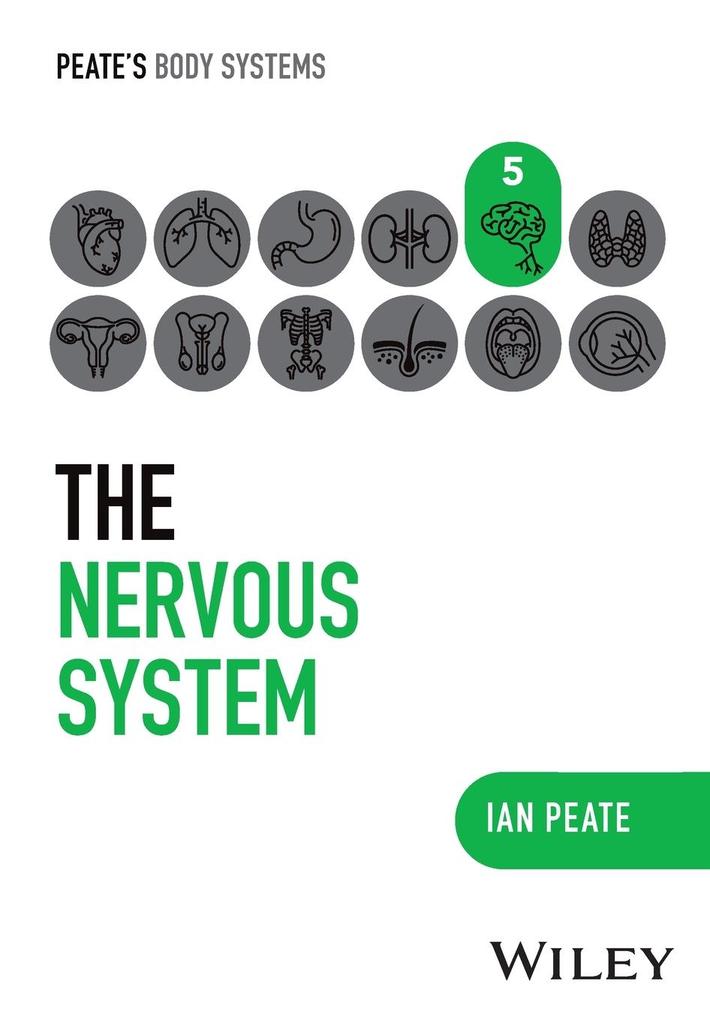PEATE'S BODY SYSTEMS THE NERVOUS SYSTEM A CONCISE, ILLUSTRATED, AND ACCESSIBLE GUIDE TO THE NERVOUS SYSTEM Each of the twelve volumes in Peate's Body Systems series is rooted in the belief that a deep and thorough understanding of the human body is essential for providing the highest standard of care. Offering clear, accessible and up-to-date information on different body systems, this series bridges the gap between complex scientific concepts and practical, everyday applications in health and care settings. This series makes for an invaluable resource for those committed to understanding the intricacies of human biology, physiology and the various systems that sustain life. The Nervous System is the perfect companion for students and newly registered practitioners across nursing and allied health fields with an interest in neurological care, providing a comprehensive yet easy-to-digest guide for both academic and clinical application.
- Equips healthcare students and practitioners with the necessary information to provide safe and competent care
- Features colourful illustrations to aid comprehension, clarify complicated concepts, and render content more engaging and accessible
- Empowers readers to adapt to a rapidly evolving healthcare landscape, preparing them for the future of healthcare delivery
- Contains information necessary for effective patient care of those with stroke, dementia, Multiple Sclerosis (MS), and other diseases and conditions of the nervous system
Inhaltsverzeichnis
Preface viii
Acknowledgements x
1 Anatomy and Physiology: The Nervous System 1
Organisation of the Nervous System 1
Sensory Division of the Peripheral Nervous System 1
Central Nervous System 2
Motor Division of the Peripheral Nervous System 2
Neurotransmitters 5
Neuroglia 5
Meninges 7
The Cerebrospinal Fluid 7
Brain 7
The Blood Supply to the Brain 11
Circle of Willis 12
The Peripheral Nervous System 14
The Autonomic Nervous System 17
Sympathetic Division 19
Parasympathetic Division 20
Conclusion 21
Glossary of Terms 22
Multiple Choice Questions 22
References 24
2 Assessment of the Nervous System 25
Assessing Needs 25
Assessing the Level of Consciousness 26
Vital Signs 30
Assessment of Pupillary Reaction 31
Motor and Sensory Assessments 31
The Patient History 32
Physical Examination 40
Assessing Mental Status 41
Cranial Nerve Assessment 41
Evaluating the System: Diagnostic Tests 45
Conclusion 45
Glossary of Terms 45
Multiple Choice Questions 46
References 47
3 Stroke 49
Pathophysiological Changes Associated with Stroke 49
Ischaemic Stroke 50
Haemorrhagic Stroke 51
Cellular and Molecular Events 51
Epidemiology 55
Risk Factors 55
Non-modifiable Risk Factors 56
Modifiable Risk Factors 56
Clinical Presentation 56
Ischaemic Stroke 57
Haemorrhagic Stroke 57
Transient Ischaemic Attacks 57
The FAST Acronym 57
Clinical Investigations and Diagnosis 58
Onset and Duration of Symptoms 58
Nature of Symptoms 59
Previous Strokes or Transient Ischaemic Attacks 59
Medical History 59
Risk Factors 59
Medication and Allergies 59
Social History 59
Psychosocial History 60
Pre-existing Conditions 60
Recent Procedures or Surgeries 60
Timing of Presentation to Healthcare Provider 60
Patient's Perspective 60
Management 63
Post-acute and Long-term Management 66
Health Teaching 67
Conclusion 69
Glossary of Terms 69
Multiple Choice Questions 70
References 71
Other Risk Factors 80
Clinical Presentation 80
Clinical Investigations and Diagnosis 84
Management 87
Caregiver Support 88
Symptom Management 88
Health Teaching 88
Conclusion 90
Glossary of Terms 90
Multiple Choice Questions 91
References 92
5 Multiple Sclerosis 94
Pathophysiological Changes Associated with Acute Multiple Sclerosis 94
Prognosis 96
Epidemiology 96
Risk Factors 97
Clinical Presentation 97
Clinical Investigations and Diagnosis 101
Management 106
Supportive Care 108
Health Teaching 108
Conclusion 110
Glossary of Terms 110
Multiple Choice Questions 111
References 112
4 Dementia 73
Pathophysiological Changes Associated with Dementia 73
Confusion 78
Mild Cognitive Impairment 78
Prognosis 78
Epidemiology 78
Risk Factors 80
6 Epilepsy 114
Equality and Law 114
Pathophysiological Changes Associated with Epilepsy 115
Epidemiology 117
Risk Factors 117
Clinical Presentation 118
Clinical Investigations and Diagnosis 119
Management 123
Seizure First Aid 123
Mental Health and Well-being 124
Equality and Diversity 124
Treatment Goals 125
Health Teaching 126
Conclusion 128
Glossary of Terms 128
Multiple Choice Questions 129
References 130
7 Raised Intracranial Pressure 132
Idiopathic Intracranial Hypertension 132
Pathophysiological Changes Associated with Raised Intracranial Pressure 133
Consequences of Raised Intracranial Pressure 135
Epidemiology 136
Socioeconomic Factors 136
Risk Factors 137
Clinical Presentation 138
Clinical Investigations and Diagnosis 140
Management 142
Monitoring 142
Medical Management 142
Ventilation Management 143
Surgical Interventions 143
Cerebrospinal Fluid Drainage 143
Psychological and Emotional Needs 144
Multidisciplinary Approach 144
Prognosis and Follow-up 145
Health Teaching 145
Conclusion 146
Glossary of Terms 146
Multiple Choice Questions 147
References 148
8 Traumatic Brain Injury 150
Head Injury 150
Pathophysiological Changes Associated with Traumatic Brain Injury 151
Mechanisms of Injury 151
Location of the Injury 151
Open Versus Closed Brain Injuries 152
Secondary Injuries 152
Epidemiology 152
Risk Factors 153
Clinical Presentation 153
Severity of Symptoms 154
Symptoms of Specific Types of Traumatic Brain Injury 154
Clinical Investigations and Diagnosis 154
Management 160
Health Teaching 161
Understanding the Injury and Its Effects 161
Medication Management 162
Cognitive and Physical Rehabilitation 162
Emotional and Psychological Support 163
Preventing Complications 163
Safety Measures 163
Conclusion 163
Glossary of Terms 164
Multiple Choice Questions 165
References 166
MCQ Answers 167
Index 168













